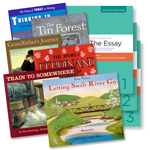Introduction to Composition: The Essay presents a modular approach to essay writing that might be used with students in grades six and above as a foundational course. The three volumes of the course make it easy to spread the course over one or two school years. Each volume should take ten weeks to complete, so it is possible to complete all three in one year. Volumes 1 and 2 should almost certainly be used within the same school year, but you might save Volume 3 for the next year.
For each of the three volumes, a Blackbird and Company Intro to Composition: The Essay guide is your core component. Additional books are essential for use with Volumes 1 and 3, and students need a dictionary, a thesaurus, and a red pen handy for use with all three volumes. Blackbird and Company sells a bundle package that includes all of the required books except for the dictionary and thesaurus, but you may also purchase the guides on their own (individually or all three together).
All volumes have five lessons each, and each lesson should take two weeks to complete. Guides have space for students to write directly in them. Since they are not reproducible, each student needs his or her own guide. Students will write a paragraph or an essay for every lesson, and they might choose to do some of their writing on a computer.
The course is supposed to be “self-directed” which means the student works independently through most of the coursework. Parents or teachers have an essential role as they evaluate student exercises and assignments and confer with students about their work. The guides provide rubrics and checklists for students to use for self-evaluation, and Volumes 2 and 3 include Teacher's Feedback forms. The parent or teacher needs to be at least somewhat familiar with course content to be able to guide students as well as to properly evaluate their work. Parents or teachers might want their own copies of each guide, but they should be able to “borrow” student guides or read ahead sufficiently without having to have separate copies.
Volume 1: Essay as Structure: Become an Architect! is used in tandem with Thinking in Threes: The Power of Three in Writing. Thinking in Threes is a great 106-page worktext that could be used on its own. It has its own writing activities that are completed in addition to those in the Volume 1 guide. While there is quite a bit of overlap in the two books, they complement each other well with the Volume 1 guide emphasizing structure and Thinking in Threes emphasizing style and writing strategies. The guide teaches students how to structure an essay with lessons on Getting Started, The Introduction (parts 1 and 2 taught over two lessons), The Body, and the Conclusion. Thinking in Threes addresses these same areas, but it does so with lessons such as “Three Ways to Connect Paragraphs and Sentences” and “Three Ways to ‘Hook’ the Reader.”
Volume 2: Write the Descriptive Essay! reinforces what was taught in Volume 1, but uses descriptive essay writing as the vehicle. While the first guide teaches the foundations of essay writing, the second volume challenges students to apply what they have learned with questions such as those on page 43: “Have I thought in threes?”, “Is my thesis statement written in parallel form (same grammatical structure)?”, and “Is my thesis statement interesting?” Questions such as these and self-evaluation forms encourage students to continually assess and improve their writing. There is no companion book for this guide.
Volume 3: Write the Literary Essay! uses five children's books, one per lesson, as the subject matter for literary analysis. The books are The Tin Forest, Grandfather's Journey, Train to Somewhere, The Story of Ferdinand, and Letting Swift River Go. While it might sound odd to use children's books, this approach actually works very well as a simpler way to introduce students to literary analysis. Each lesson works students through the writing process with preliminary exercises as they create elements to use in their essays, write a rough draft, do their own evaluation, work through the teacher's evaluation, and then write a final paper. They do not simply write summaries of the stories. Instead, they learn to think more deeply about the meaning and ideas that surface as they read the stories then they develop their own thoughtful essays that address significant aspects of the stories.
Intro to Composition is carefully crafted to walk students through progressive skill-building steps that challenge students to learn on their own. I very much like the design of the course with the variety of activities, the use of the supplemental books, and thoughtfully designed writing assignments as well as the quality of writing that these will likely elicit from students.
For those interested in continuing the series with high school students, see my review of Volumes 4 through 6.









